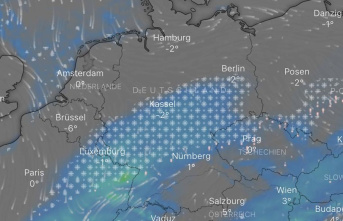Never since systematic measurements began almost 40 years ago has the concentration of the powerful greenhouse gas methane in the atmosphere increased as much as in 2021.
The World Weather Organization (WMO) in Geneva is puzzled: "The reason for this extraordinary increase is not clear, but seems to be due to both biological and man-made processes," it reported on Wednesday. The concentration of methane in the atmosphere reached a high in 2021, as did that of carbon dioxide and nitrous oxide - each since measurements of these greenhouse gases began.
Regarding the rise in methane concentrations, WMO boss Petteri Taalas said in New York that there were indications that this "comes very strongly from the tropical areas where we have wetlands". In addition, the methane also comes from agricultural activities. However, there is a "trend towards higher emissions from natural sources - but we don't have very reliable numbers".
More harmful to the climate than CO2
Methane (CH4) is the second largest contributor to climate change after carbon dioxide (CO2). It is created where organic material is broken down in the absence of air. It is 25 times more harmful to the climate than CO2. However, it lasts much shorter in the atmosphere. In the case of methane, it's a good ten years, and in the case of CO2, a considerable proportion is still in the atmosphere even after centuries.
CO2 contributes around two thirds to the greenhouse effect, methane a good 16 percent and nitrous oxide around 6.5 percent. All greenhouse gases combined have led to an average global warming of 1.1 degrees since the late 19th century. In Germany it was 1.6 degrees.
Talaas also saw something positive in the development: The world is currently not on course for the Paris 1.5 degree target, but rather for 2.5 degrees - but: "The good news is that we are no longer on heading for three to five degrees." The world has started to move in the right direction, but not fast enough.
According to WMO estimates, the global average concentration of methane rose by 18 to 1908 ppb (parts per billion) in 2021. The year before, the increase of 15 ppb was also significantly higher than the long-term average. 1908 ppb is 262 percent of pre-industrial levels.
wetlands and paddy fields
A large part probably comes from wetlands and paddy fields, writes the WMO in its annual greenhouse gas bulletin. It is still unclear whether this is a consequence of climate change, for example because wetlands are becoming wetter and warmer. The warmer, the faster organic matter breaks down, and aquatic breakdown without oxygen leads to higher methane emissions. But the WMO also writes: "The dramatic increase could also be due to natural annual variability."
In the case of carbon dioxide, the increase in concentration from 2020 to 2021 was higher than the average for the ten previous years. The concentration increased by 2.5 to 415.7 ppm (parts per million - particles of CO2 per million particles) in 2021. This corresponds to 149 percent of the level before the start of industrialization around 1750. CO2 is produced, for example, by the burning of coal, oil and gas, cement production and other industrial processes as well as the destruction of forests.
Depending on the measuring stations and calculation methods, the WMO values deviate slightly from information provided by the US climate authority NOAA, for example. The WMO forms an average from the measurements of several stations.












